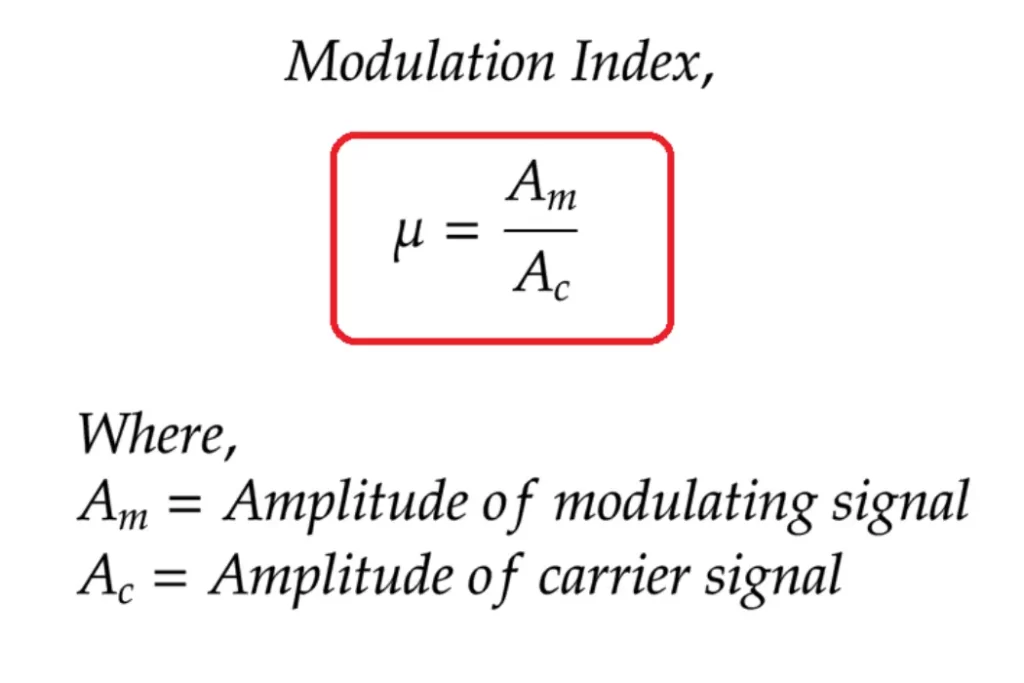In the world of telecommunications, the efficient transmission of information is crucial. One vital aspect that directly affects the quality of the transmitted signal is the modulation index. The modulation index plays a pivotal role in various communication systems, determining how effectively the information is carried by a carrier wave. The exploration of Modulation Index and its impact on signal quality serves as a significant source of knowledge for understanding the efficiency of transmitted signals in communication systems. In this article, we will delve into the concept of modulation index and explore its impact on signal quality.
How to Calculate Modulation Index
The modulation index can be calculated using the formula:
Modulation Index(m)=Am / Ac
Where:
Am is the peak amplitude of the modulating signal,
Ac is the peak amplitude of the carrier signal.
Understanding Modulation Index
The modulation index, often denoted as “m,” is a dimensionless quantity that defines the extent of modulation applied to a carrier wave by a modulating signal. It is a ratio that represents the amplitude or frequency deviation of the modulating signal concerning the carrier signal.
How Modulation Index Affects Signal Quality
High Modulation Index and Signal Distortion
When the modulation index is too high, the carrier wave experiences significant amplitude or frequency variations based on the modulating signal. While this might sound advantageous, it can lead to signal distortion and unwanted sidebands. As a result, the transmitted signal may become difficult to interpret, leading to a loss of information.
Low Modulation Index and Signal Clarity
Conversely, a very low modulation index may result in a weak modulation effect on the carrier wave. This can lead to poor signal clarity and make the transmitted information challenging to extract accurately.

Factors Influencing Modulation Index
Several factors influence the modulation index in a communication system. Understanding these factors is crucial in maintaining optimal signal quality.
Carrier Frequency
The carrier frequency is a fundamental factor affecting the modulation index. Higher carrier frequencies often require a lower modulation index for effective signal transmission.
Modulating Signal Amplitude
The amplitude of the modulating signal determines the depth of modulation applied to the carrier wave. A higher modulating signal amplitude results in a higher modulation index.
Modulating Signal Frequency
The frequency of the modulating signal also impacts the modulation index. Higher frequencies generally lead to a higher index value.
Types of Modulation Schemes
Different modulation schemes, such as amplitude modulation (AM), frequency modulation (FM), and phase modulation (PM), can affect the modulation index in distinct ways.
Importance of Modulation Index in Communication Systems
The modulation index holds significant importance in various communication systems due to its impact on signal quality.
Wireless Communication
In wireless communication, a balanced modulation index is essential to ensure clear and reliable transmission of data.
Broadcasting
Broadcasting systems heavily rely on a well-regulated modulation index to deliver high-fidelity audio and video signals.
Two-Way Radio Systems
Two-way radio systems benefit from an optimized modulation index to facilitate efficient two-way communication.
Modulation Index in Digital Modulation
Digital modulation techniques also utilize the concept of modulation index in their operation.
Phase Shift Keying (PSK)
In PSK, the modulation index represents the phase deviation of the carrier signal.
Frequency Shift Keying (FSK)
In FSK, the modulation index denotes the frequency deviation from the carrier frequency.
Amplitude Shift Keying (ASK)
In ASK, the modulation index signifies the amplitude variation of the carrier signal.
Strategies for Improving Signal Quality through Modulation Index
To enhance signal quality, various strategies are employed to maintain an optimal modulation index.
Pre-Emphasis and De-Emphasis Techniques
Pre-emphasis and de-emphasis techniques can be used to boost higher frequencies during transmission and restore the original signal at the receiver end.
Noise Reduction Techniques
Implementing noise reduction techniques helps reduce signal interference and improves overall signal quality.
Error Correction
Incorporating error correction mechanisms aids in mitigating data loss during transmission, leading to improved signal clarity.
Real-World Applications of Modulation Index
The concept of modulation index finds practical applications in various real-world communication systems.
Mobile Communication Systems
Mobile communication systems utilize modulation index optimization to ensure reliable voice and data transmission.
Satellite Communication
In satellite communication, the modulation index plays a crucial role in transmitting signals across vast distances.
Television Broadcasting
Television broadcasting heavily relies on the modulation index to deliver high-definition video and audio signals.
Conclusion
The modulation index is a vital parameter that significantly impacts the quality of transmitted signals in communication systems. Striking the right balance in modulation index is essential to achieve clear, reliable, and efficient signal transmission. By understanding and implementing appropriate modulation index strategies, we can enhance signal quality and ensure seamless communication.


